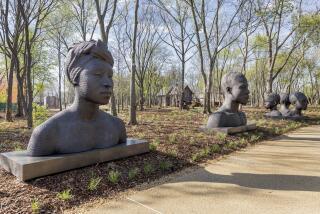Felix de Weldon, 96; Sculptor of Famous Marine Corps Memorial
- Share via
He sculpted bronze busts for kings and presidents and created monumental sculptures that are displayed around the world.
But Felix de Weldon’s best-known work is on the edge of Arlington National Cemetery: a 100-ton, 78-foot-tall bronze sculpture that captures one of the defining moments of World War II.
For the record:
12:00 a.m. June 11, 2003 For The Record
Los Angeles Times Wednesday June 11, 2003 Home Edition Main News Part A Page 2 National Desk 1 inches; 39 words Type of Material: Correction
De Weldon obituary -- A caption accompanying the obituary of Felix de Weldon in Tuesday’s California section incorrectly said a photo of President Truman, De Weldon and Joe Rosenthal was taken in 1954. The picture was taken in 1945.
De Weldon, who created the U.S. Marine Corps War Memorial depicting the historic raising of the American flag on Mt. Suribachi on Iwo Jima, died of causes associated with old age on June 2 in a nursing home in Woodstock, Va. He was 96.
During a career that spanned more than 70 years, De Weldon created more than 1,200 public monuments on seven continents, including a monument of Adm. Richard E. Byrd at McMurdo Sound in Antarctica.
The Vienna-born sculptor, who immigrated to the United States via England and Canada and became a U.S. citizen in 1945, has sculptures in 44 states. Among them: a Revolutionary War monument in Philadelphia, a Civil War monument in Fredericksburg, Va., and a bronze of Fleet Adm. Chester W. Nimitz at the Naval Academy Museum in Annapolis, Md.
Washington, D.C., holds 33 of his public sculptures, including a bronze equestrian statue of Simon Bolivar, the American Red Cross Memorial and busts of presidents Dwight D. Eisenhower and Harry S. Truman.
De Weldon also created the bust of President Kennedy on display at the John F. Kennedy Memorial Library in Boston, and Graceland in Memphis boasts a De Weldon bust of Elvis Presley.
But the sculpture that is considered De Weldon’s masterpiece is the massive Marine Corps War Memorial.
He was the official artist for U.S. Naval Aviation, stationed at Patuxent Naval Air Station in Maryland in early 1945, when a copy of Joe Rosenthal’s now-famous photograph of Marines raising the American flag atop Mt. Suribachi came over the Associated Press wire. “When I saw the picture, I immediately recognized it would capture the imagination of the American people,” De Weldon told the Washington Times in 1995. “The strength, the unison of action, the will to sacrifice to hold our flag high -- that symbol of our liberty and freedom.”
Iwo Jima is considered one of the bloodiest battles of the war; more than 6,000 Americans were killed, and more than 17,000 were wounded.
Inspired by Rosenthal’s powerful image, De Weldon worked nonstop for three days and nights creating a 3-foot-tall wax model using the only materials he could find: a mixture of floor wax and sealing wax.
The model so impressed his commanding officer that he sent De Weldon and the wax statue to Navy headquarters in Washington.
De Weldon said he never forgot the sound of applause as the model was wheeled down to the commandant of the Marine Corps.
Government officials asked De Weldon to create a 9-foot plaster version of the statue, which toured the country to help sell war bonds. After he was discharged from the military, Congress passed a joint resolution commissioning him to do the large-scale sculpture of the historic event captured in Rosenthal’s Pulitzer Prize-winning photo.
It took him and his assistants nine years to complete the statue, six years for the model and three for the bronze.
“Each finger,” he once said, “was the size of my arm.”
The $850,000 cost of creating the statue and developing the memorial site was paid for by donations to the Marine Corps War Memorial Fund.
The monument was dedicated on Nov. 10, 1954. In his dedicatory address, Vice President Richard Nixon called it “a symbol of the hopes and dreams of all Americans.”
Born in Vienna, Austria, on April 12, 1907, De Weldon was the son of a wealthy textile manufacturer.
He studied art and sculpted in prep school and at 17 won his first national sculpture competition and began exhibiting his work.
He graduated from Vienna’s Marchetti College in 1925 at age 18 with a bachelor of arts degree. He received masters of arts and science degrees from the University of Vienna’s Academy of Creative Arts and School of Architecture, where he also received a doctorate in architecture.
After studying archeology at Oxford University, he set up a studio in London. In 1935, he was commissioned to create a bust of King George V to commemorate the 25th year of his reign. The bronze bust now stands in the National Portrait Gallery in London.
A year later, he was commissioned to create the coronation bust of King Edward VIII and, after King Edward’s abdication, he was commissioned to create the coronation bust of King George VI.
De Weldon, who was appointed to the President’s Commission of Fine Arts in 1950 by President Truman, was reappointed to the commission by Eisenhower and Kennedy.
He is survived by his second wife, Joyce; two sons; and a sister.
More to Read
The biggest entertainment stories
Get our big stories about Hollywood, film, television, music, arts, culture and more right in your inbox as soon as they publish.
You may occasionally receive promotional content from the Los Angeles Times.










